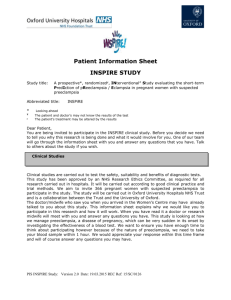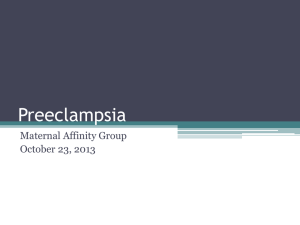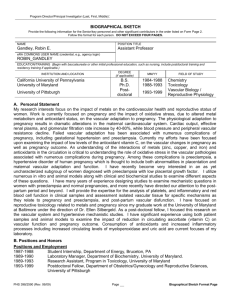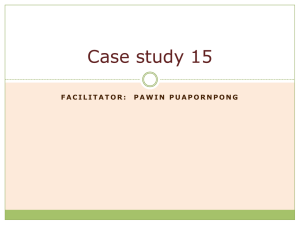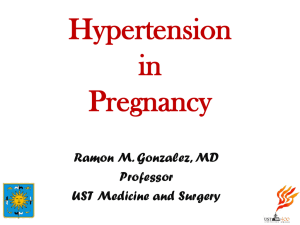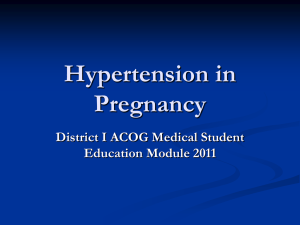High-Risk Antepartum Nursing Care: Preeclampsia & Eclampsia
advertisement
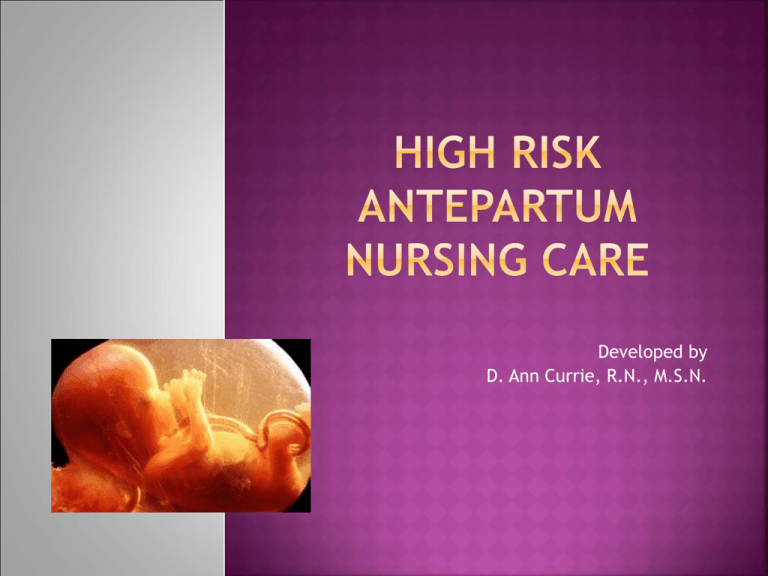
Developed by D. Ann Currie, R.N., M.S.N. Begins prior to pregnancy for those women with disease processes or conditions such as Cardiac disease, Diabetes Mellitus, Systemic Lupus Erythematosus, etc. It may also will begin with the first prenatal visit and will continue throughout the pregnancy, into the intrapartum , and postpartum periods. Many factors may influence the Outcome of a Pregnancy. The nurse should be able to assess and identify those factors that place the the Antepartum Client at risk. Age-under 17 or over 30-35 Lower Socioenomic Race-Afro-American or Hispanic Nutritional Status Environmental Factors Pregestational Conditions Substance Abuse Infections-STI’s, TORCH, and other No Prenatal Care See text for complete list Pregnancy –induced Hypertension disorders: Preeclampsia Eclampsia HELLP syndrome Pregnancy-induced hypertension( Gestational Hypertension Chronic Hypertension A hypertension condition which may occur in pregnancy starting in the third trimester of pregnancy, and/or the intrapartum, and/or postpartum periods. The clinical manifestations include: Hypertension- B/P over 140/90 Proteinuria ? Edema( if client has generalized edema with other clinical manifestations Others …. Depending on severity Types- mild, moderate, and severe Risk Factors: Nulliparity Maternal age-teens under 19 or over 30 Race-Afro-American and Hispanics Lower Socioeconomic status Family history of preeclampsia Chronic hypertension Diabetes mellitus Systemic Lupus Erythematosus Multigestation Gestational Trophoblastic disease Fetal hydrops Complications Preeclampsia of Hypertensive Crisis Pulmonary edema Renal Failure HELLP DIC Eclampsia Cerebral Vascular Accident Blindness Hepatic Failure Hepatic Rupture Abruptio placenta Uteroplacental insuffiency IUGR Preterm delivery Fetal Death Maternal Death-3th leading cause of maternal mortality in USA Mild Preeclampsia: Hypertension over 140-/90 –MAP-over 105 Proteinuria( over 1+)0.3grams/liter in a 24 hour urine collection Weight gain(2-2.5 pounds/week) ?edema Other Moderate Preeclampsia: B/P-160/100 Proteinuria-+3 Edema facial and finger Visual Problems Severe Preeclampsia:: B/P – Over 180/110 ,MAPProteinuria- 3+to4+ or more than 500grams in a 24 hour specimen. Oliguria-less 400-500ml/day or less than 30 ml/hour Sudden large weight gain Generalize edema-facial, lung may have crackles Central nervous system irritability: Headaches Hyperreflexia-DTR’s greater than +3-+4 with clonus Visual disturbances-scotomata or burred vision Cont-Severe Preeclampsia Hepatic involvement- upper right quadrant pain or epigastric pain. Pulmonary edema others Nursing Assessment guidelines for the client with preeclampsia: Obtain a thorough history • Past medical history-check risk factors Past Obstetrical history Current pregnancy history • • • Assessment of the various systems • • • • • • • Cardiovascular assessment: Vital signs and B/P frequency will depend of severe of preeclampsia Ausculate heart sounds and lung sounds Assess for edema-generalized pitting and pulmonary edema Daily weight-A.M. same scale Check capillary refill CONT. -Nsg. Assessment • • • • • • • • • • Respiratory Assessment: Assess respiratory rate, quality, and pattern Ausculate lung sounds Assess skin color. Monitor oxygenation with pulse oximetry if indicated Renal Assessment: Assess Strict Urinary Output- frequency will depend on severity of preeclampsia maybe as often as every hour. Assess for Protienuria-dipstick Maintain 24 hour urine collect Monitor laboratory valves-Electrolytes, BUN, Creatine, Serum protein, Uric acid Cont. Nsg. Assessment• Hematologic• Monitor Laboratory Studies • • • • • • • • • • CBC-RBC, PLT, Hg, and Hct Coagulation profile-fibrogen, fibrin split products, coagulation factors, PT ,and PTT Monitor client for bleeding-in urine, bruises, etc. Central Nervous System Assessment Assess DTR’s Assess level of consciousness Pain- headaches Visual changes Assess for clinical manifestation of ICP-H/A, N/V, etc. Change in behavior Liver Assessment Assess for pain-epigastric or upper right quadrant pain Monitor Liver Functions: LDH SGOT SGPT Alkaline phosphate Bilirubin Assess Skin Color Fetal Assessment Fetal movement NST Biophysical Profile Uterine Assessment Monitor for uterine contractions Assess for Uterine bleeding-Placental abruption. Assess for clinical manifestations of uteroplacental insufficiency- AFI under 5cm or Decrease FM Nursing Diagnoses: Alt.Tissue Perfusion-Cerebral, Uterine, Renal , etc relate to Vasospasms Risk for Injury Fluid Volume Deficient Nursing Care for the client who has Preeclampsia: depends on the severity of the disorder. Mild Preeclampsia: Bedrest at home-BRP- Bed exercises Frequent rest periods or naps Diet high in protein-70grams-100grams and no added salt/ no salty foods-2-4grams of sodium Daily Weights- A.M. Assessment of B/P , dipstick urine for protein. Fetal movement counts Teach client/family signs to report to health care provider that may indicate complications Client will frequent visits will the doctor-discuss the importance of these visits Provide support for client’s/family’s concerns and fears. Moderate Preeclampsia: The client with moderate and severe Preeclampsia will be admitted to the hospital. SEVERE PREECLAMPSIA: Bed rest Decrease CNS stimulation: A quiet calm environment: Lights low Limit visitors Prepare Room/equipment for emergencies : Pad side rails Oxygen and suction setups IV equipment that can handle several kind of medications or lines Dinomap and pulse oximeter Fetal Monitor for continuous monitoring Foley catheter Preeclampsia tray: Emergency equipment and drugs including : Calcium gluconate Valium SEVERE PREECLAMPSIA: Complete initial and continuous assessment( see guideline for assessment) Diet – maybe high in protein or NPO Vital signs- B/P, HR, RR, and FHR every 15 minutes Intake and output every hour-strict Deep tendon reflexes every 15 minutes Daily Weights Position client in lateral position Monitor IV infusions Monitor laboratory tests SEVERE Magnesium Sulfate-Antidote-Calcium gluconate Hypertensive agents: PREECLAMPSIA: Medications Methyldopa-Aldomet Hydralazine- Apresoline Labetalol-Normodyne Nifedipine-Procardiac xl Nitroprusside sodium-Nitropride Glucorticosteriods-solu-medrol Diazepam-Valium and/ or Phenytoin- Dilantin Diuretics- Lasix-only with CHF or pulmonary edema ECLAMPSIA is the development of: Convulsions(seizures) Tonic-Clonic seizures Coma in the client who has clinical manifestations of preeclampsia. It can occur in the antepartum, intrapartum, or postpartum periods. Nursing Care: Seizure care- refer to med-surg. text Monitor fetal status and prepare for delivery Prevent complications Administer Medications HELLP Syndrome is a multisystem condition, a severe form of preeclampsia in which the client may present with a variety of clinical manifestations. Exhibits common laboratory markers: H: Hemolysis.-Low RBC, present of burr cells EL: Elevated Liver enzymes .- All liver functions will be high LP: Low Platelets.-PLT.-less than 100,000 The progression from severe preeclampsia to the development of multiple organ involvement and damage leads to HELLP. The client may complain of malaise, epigastric or upper right quadrant pain, nausea and vomiting, or vague symptoms ( not feeling well). She may be pale or jaundice. Nursing Care Assessments and management of care is the same as severe preeclampsia. Monitor laboratory values: CBC Liver Function Tests Coagulation Studies Type and Crossmatch Possible Blood Transfusions and /or Platelet Cont. NSG. Care: Prepare for delivery Notify Charge nurse ,Anesthesia staff, and INC Client will go to a Intensive Care Unit Clint will have a Central line placed. Medical or surgerical physicians maybe called in. Equipment maybe needed from the surgery unit. Pregestational Maintain B/P within normal limits Observe for complications Medications: Hypertension The pregnant client should not take ACE Inhibitors or Beta Blockers for antihypertension agents. Also Diuretics are usually not given except with the client will CHF Monitor Fetal Well Being Assist client to use non- pharmacological methods to help to control blood pressure. ECTOPIC PREGNANCY GESTATIONAL TROPHOBLASTIC DISORDER ABORTIONS PLACENTA PREVIA ABRUPTIO PLACENTA ECTOPIC PREGNANCY is one in which the fertilized ovum implants in a location other than the endometrial cavity of the uterus. The Fallopian Tube is the most common site. The risk of an ectopic pregnancy increases with STI’s and with increase age(35-45) Ectopic pregnancy is a significant cause of first trimester maternal deaths. Clinical manifestations: Mild vaginal bleeding Abdominal pain Palpable mass Signs of blood loss Ultrasound will confirm an extrauterine pregnancy Management of the ectopic pregnancy: Surgerical involves laparoscopy or laparotomy for salingectomy with the partial or complete removal of the fallopian tube or removal of the ectopic pregnancy from other sites. –Prep for surgery Alternate method to surgery is administer of Methotrexate Only if the fetus is under 2.5-3.5 cm. Single dose Follow-up with ultrasounds and beta-hCG Start IV as soon possible- be prepare to give blood Provide emotional support to the client If client is Rh-negative administer RhoGam Monitor client for hemorrhage and infection Discharge Instructions : Teach client to report signs of infection and/or blood loss to the health provider Anemic clients should take iron supplements Importance of follow up care. GESTATIONAL TROPHOBLASTIC DISEASE is also know as Hydatidiform Mole or Molar pregnancy. It is an abnormal growth of the trophoblasitc tissue including the placenta and chorion. Risk Factors: Clients of Southeast Asia- Japanese or Taiwan descent Mothers over 40 Possibly Vitamin A deficiency Previous GTD. Complications: Hemorrhage Infection Choriocarcinoma DIC Clinical Manifestations: Vaginal Bleeding- red to prune color Severe nausea and vomiting Uterine size greater than dates Passing on grape-like vesicles No fetal parts palpated and no FHR heard Abnormal labs : Very high hCG levels Very low MSAFP Possible low Rbc, Hct, and Hg Clinical Preeclampsia prior than 20 weeks Ultrasound will have characteristic “snow storm” pattern with no fetus Nursing Manifestations: Care for client who has GTD: Monitor Vital Signs Insert IV catheter and maintain IV infusion Prepare the client for surgery-suction uterine evacuation of mole. Administer RhoGam is client is Rh-negative. Administer chemotherapy as order- Methotrexate Cont. Teach client: NSG. Care: About the disease process, and treatment The need for follow up care for a year Weekly hCG testing at first, than every 3monthsfor a year No pregnancies for at least one year and the use of contraception Signs of problems to report to the health care provider About the Medications being used Acknowledge and support the need to grieve the loss of the pregnancy • • An ABORTION is the termination of a pregnancy prior to 20 weeks. In Texas a fetus must have two of the three criteria’s; be under 20 weeks, or under 500 grams, or under 14 inches, to be considered an abortion. Types of Abortions: • • Spontaneous- lay term is Miscarriage Elective or Therapic-surgically or medically induce termination of the pregnancy. TYPES of SPONTANEOUS ABORTIONS: Threatened Abortion Inevitable Abortion Incomplete Abortion Complete Abortion Missed Abortion Reoccurring Abortions (Habitual Abortion) Septic Abortion Risk Factors: vary Clinical manifestations: May vary Vaginal bleeding Cramping May have cervical dilation May pass tissue and/or clots Dull backache Regression of signs of pregnancy Falling hCG levels No fetal heart tone Smaller uterine size Signs of infection in infection is present Nursing Care: Depends on the type of spontaneous abortion Bedrest and no sexual activity if threaten abortion Save any tissue pass Prepare for surgery: dilatation and curettage(D&C) Assess client Insert IV catheter and maintain IV infusion Obtain lab specimens and sent to lab: CBC Type and Rh- Type and cross match Serum beta-hCG Possible coagulation studies Prepare for ultrasound Administer RhoGam if client is Rh-negative Provide emotional support remember this a loss Refer to pregnancy –loss or grief support groups If client spontaneous loses baby 0r it is an intrauterine death and if the client/family would like to view and/or visit with baby, Provide the opportunity in a private area Allow the client to name the baby Take pictures Give something for the client to take home Clean the baby with soft cloth or cotton Never give a cold baby…Wrap in warm blankets Allow family to visit Provide the opportunity for religion beliefs Elective Abortion is the intentional termination of pregnancy before 20-24weeks. Therapeutic Abortion is the termination of the pregnancy for medical reasons. The termination of the pregnancy is done by surgery – Dilatation and Curettage (D&C) or with medications called abortifacts The nurse should be aware of the state’s specific regulations governing abortions. Abortions have many ethical issues. The nurse should know beliefs concerning this issue.



